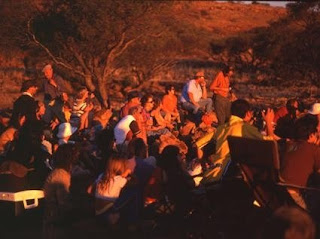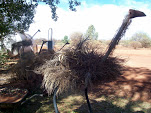* provides intense personal, intellectual and spiritual engagement
* source of relaxation
* entertainment
* social opportunities
* communication
* express ideas
* strengthen social bonds
* increases participation in decision making
* increases creativity in decision making
* builds community capacity
* strengthens identity
* sense of place
* provides meaning
* pleasure
* emotional stimulation
I wanted to explore some of these ‘reasons for arts engagement’ and started to collect data and interview people on the arts in their communities. I spent just under two weeks in three shires within the Murchison region. The Murchison region broadly relates to the catchment area of the Murchison River and encompasses pastoral, mining and indigenous communities within Western Australia’s Mid West region.While the data is quite raw, I wanted to get a few initial findings and thoughts down early, just to see what came out of these initial interviews while the ideas are still fresh. For people in the Murchison region I found that many of these broad claims held. However, the main reasons why people in the Murchison engage in the arts includes the creation of great art, for networking and social opportunities, entertainment, recreation and pleasure, a positive outlet in a safe venue, and to expand potential career opportunities by increasing both skills and confidence.
Creating great art
For the most part, the community acknowledged different levels of arts engagement. There was a distinction made between professional artists, who worked solo and produced high value works of art and those who engaged as a hobby, recreation and social reasons.
“There is different levels when it comes to art. First you’ve got your acknowledged artists and they need to be supported somehow with accessing material at an affordable level, helping them to market their product. That’s difficult to do in a town like this, again, because you’ve got that family group dynamic.”
Many artists interviewed downplayed the social aspects of art groups and even went so far to suggest that belonging to an art group had a detrimental effect on creativity and the artistic integrity of their work. One artist suggested that he noticed a distinct change in his work after going to the art group for a while. He tended to paint more scenic and landscape pictures, lamenting the subsequent lack of integrity and artistic edge.
“A Saturday morning art group used to meet…the group was mostly for gossip and catching-up and was made of the partners of workers and miners in town. The group no longer exists. It was more about the ‘social’ than the art. The art produced was less expressive with less meaning.”
Networking and Socialising
Testament to the number of craft, pottery and quilting groups across rural Australia is the social and networking opportunities affording by belonging to such groups. The participants themselves would not normally consider themselves artists and their produce was often made for charity, friends and family. There is a lack of recognition and appreciation of craft as art because of the focus of craft as a hobby and not as a profession.
“There are individual artists doing their own thing, and then there’s a group of people who get together to do craft stuff, but I think I there is a loss of understanding of how that is art in some way, because they tend to see that as hobby and not art.”
The socialising and networking opportunities afforded by such groups works well for a small population when there is not a critical mass to make other activities, like sporting teams viable. The craft groups bring disparate groups together, providing social opportunities and a meeting place. This is of particular importance for this region where distance and isolation can be drivers for depression and other mental health issues.
“All the station ladies have a key and can use the centre whenever they want. The group is wonderful for the wellbeing of the station ladies. Gives them a place to hang out when they come to town. To have a cup of tea and to do some art while waiting to pick up the kids.”
“Art and music brings people together”
With a particular reference to the indigenous communities it seems that visual art, craft and music plays a powerful role in bringing people together. This is of considerable significance when there is, not just historical and racial divisions in a community, but also divisions between different family or skin groups.
“The art has helped to break the ice. [The service] is now more like a drop-in centre. The families in this town do not participate in activities across skin groups.”
Entertainment and a good night out
Touring shows can provide light relief and an escape from the mundane hum-drum of everyday life. It is also interesting that touring shows and concerts bring a lot more people out of the woodwork. Attendance figures at a recent touring production of a play based around shearing teams show greater participation by the community than could be afforded by any other form of arts activity. People might not necessarily want to commit the time or the energy to putting on their own play or starting a drama group, but a commitment of a couple of hours to watch a show provides much needed light entertainment and relief, as well as social opportunities without any ongoing or longer term commitment.
Tourism and additional income
As already mentioned there is a distinction made between the professional artists and those who engage in the arts and craft for hobby or recreation. They both provide pleasure and recreation on an individual level, but they also have the potential to provide additional income for the artist through sales to tourists. It was not unusual in this region for handmade trinkets and other items by local artisans and craft people to be offered for sale at the tourist centre, craft shops and local public houses.
“Art & culture is the major industry of the town. Women paint coffee cups on their front porch.”
The problem with the tourist market is that the difficulties with getting materials means that items are not always the best quality, and often underpriced. They provide a cash income to locals, but this practise is often criticised as it undermines the development of integrity within the work as the temptation for a quick sale means the work is often not developed, documented, or even paying the artist what its worth. The artist looses out in the long term because they are not given an opportunity to build a body of work, and develop their own style for an international market with the potential for much higher returns.
“The indigenous people paint strictly for money. They are chasing the tourism dollar.”
Positive Alternatives
The arts provide time for reflection and introspection, especially when quiet and safe spaces, such as a women’s centre, are dedicated to art.
“It can be used therapeutically as well. A lot of women like to come together around painting. So [a social worker] just bought a lot of canvas and paint and stuff and just set it out there and women started coming… as they’re painting they start talking… as they got to know her they started opening up to her and talk more.”
The same principle applies to young people. The arts, especially music and dance, is seen by many as a positive alternative for destructive or anti-social behaviour, such as vandalism, graffiti and other petty crime. The arts activity provides a focus for the young people which can take place in a safe and supervised environment.
“This place is boring, you have youth wondering around, adults wondering around, bored to tears.”
“A band jamming session, or something like that brings the community together, it gives people something to get involved with over time”
Art in this sense not only assists in helping know your own abilities and provide a sense of achievement, but provides an alternative to what would otherwise be considered destructive and anti-social behaviour. The arts activity takes place in a safe venue and provides a haven for individuals to spend time for themselves and not be concerned with family issues.
Expanding career opportunities
Difficulties with both the nature of the population and the funding structures has restricted many projects to one-off, short term, however this is not always seen as a negative. One-off projects help the community identify talent, expand career opportunities and develop networks and relationships within and across communities and across agencies and different groups. On-off projects have provided formal qualifications, opportunities and experience which benefit the participants beyond the life of the project.
“its not just a once-off thing, and it helps us identity talent that we can support out of this town. Hopefully some of them will go on to do a few things, they don’t all have to become stars, but they could become art teachers or music teachers or whatever.”
In one participant’s case, a one-off workshop provided training that helped her get a job in a neighbouring town. Furthermore as these opportunities are not available on a regular basis, local residents, and particularly children and young people, don’t have the opportunity to know what is possible, to know what kind of future they could want for themselves. So many talents and potentials may go untapped and unnoticed simply because people were never given an opportunity to know what is possible.
“I think, if people can start seeing a future for themselves, a little bit of light down the tunnel, that it gives them hope and a sense of purpose… for a long time I think for a large part of this community there was just no vision for a future, it was just surviving day by day.”
Conclusions
Just from personal observations, there is a large number of very creative people residing in these towns and their reasons for engagement in the arts are just as diverse as the forms and ways in which that engagement can take place. I have demonstrated here a full spectrum of reasons for engaging in the arts from personal achievement and pleasure, to social opportunities and a supplementary income, as well as a means to develop skills, provide time-out and hope for the future.
Thank you for reading this far – boy, it’s a long one isn’t it? I look forward to receiving any feedback on some of the issues I have raised.





